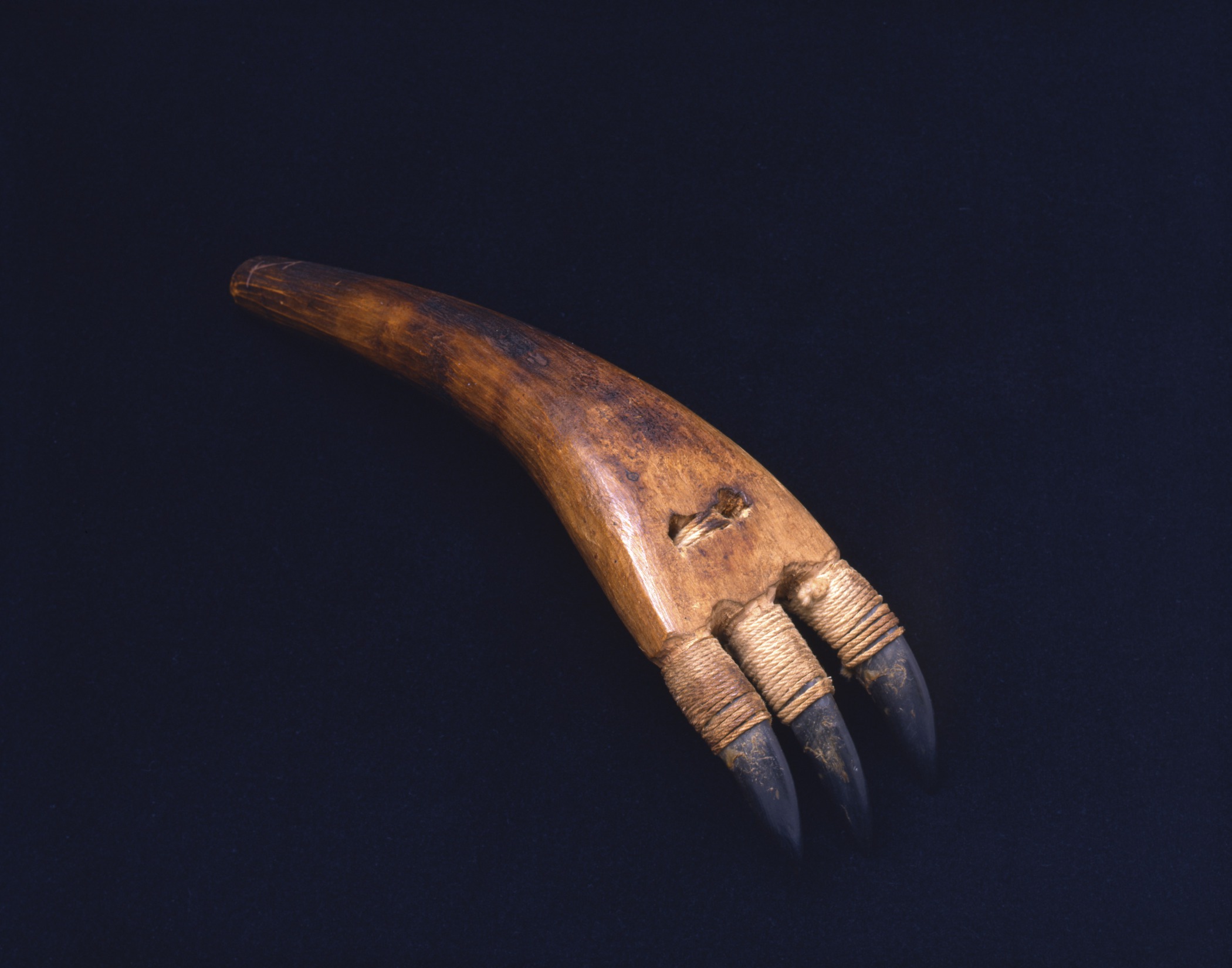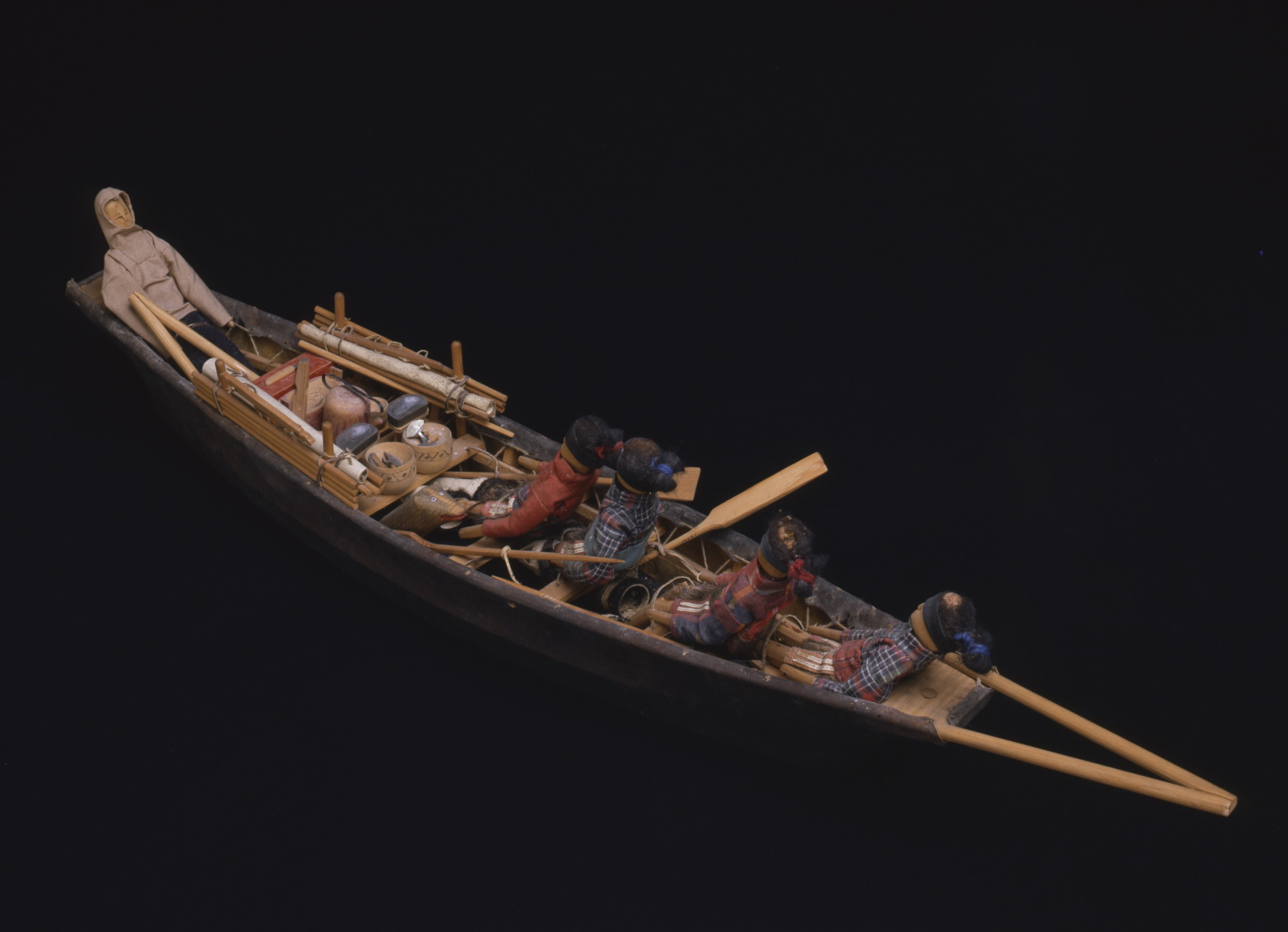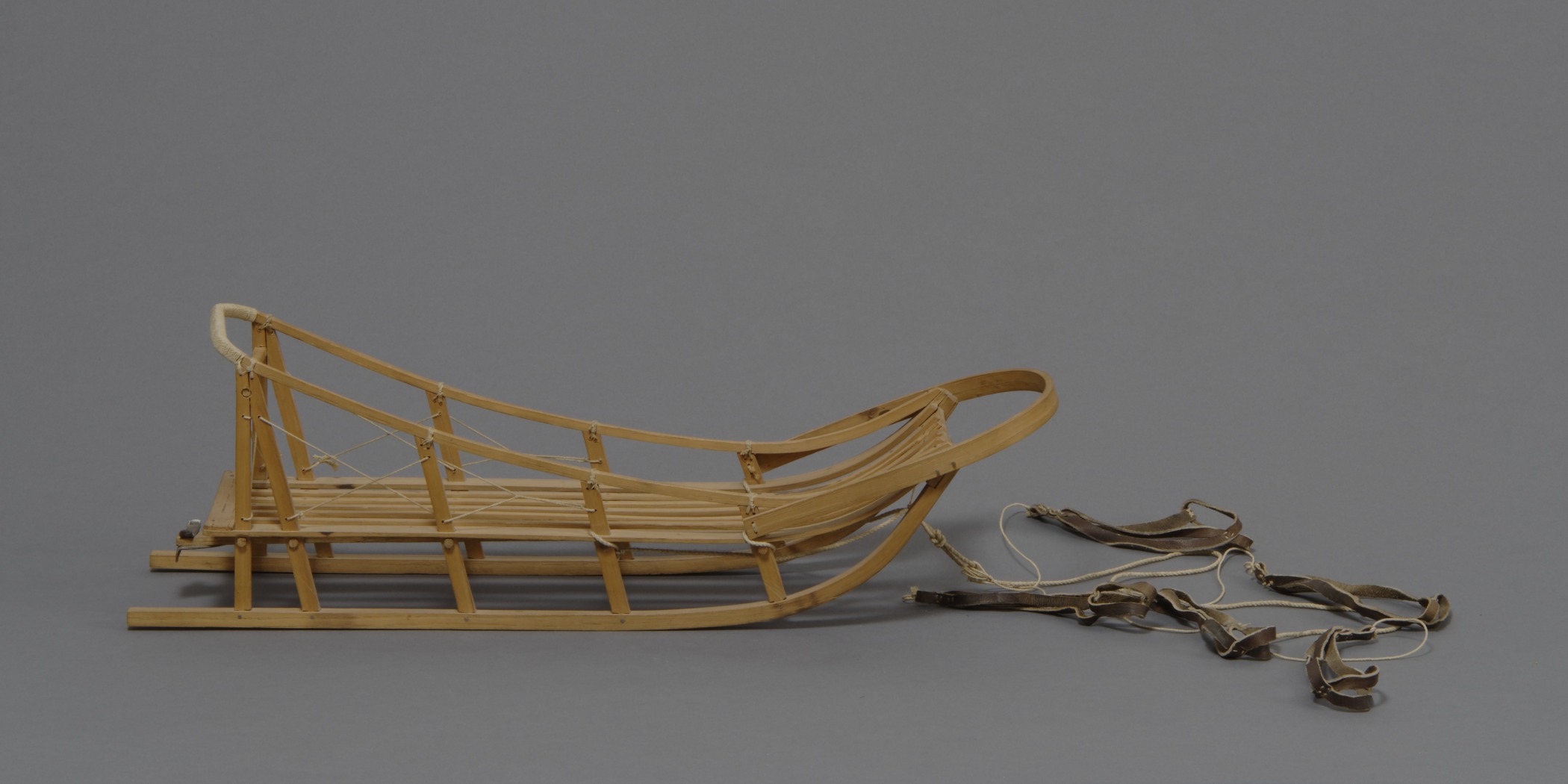Kalaallit (West Greenlandic Inuit)
Souvenir model umiak with four women, one man, a dog, and camp equipment
- Early to mid-20th century
- Sealskin, wood, cloth, metal, and hair (?)
- 4 3/16 × 5 1/2 × 37 13/16 in.
Hood Museum of Art, Dartmouth College: Gift of David C. Nutt, Class of 1941; 159.9.14387
visibilityLook & DiscussArctic hunters made two types of boats: kayaks and umiaks. Both were critical for transportation and hunting. The umiak is a type of skin boat used throughout the Arctic for over 1,000 years. While a kayak is meant to hold one to three people, the larger umiak can hold up to 30 people and their possessions. Umiaks were traditionally used to transport people and their possessions to seasonal hunting grounds, and for hunting large mammals, like whales, and walrus. They could be propelled through the water with oars or paddles or with a sealskin sail. Like kayaks, umiaks traditionally consisted of a driftwood or whalebone frame pegged together with antler or ivory, and then covered with stretched sealskin hides sewn together. They were strong enough to carry a heavy load but were light enough to be carried over the ice. Modern umiaks use a similar construction but now include screws and bolts.
This model umiak carries five passengers, a dog, and equipment to make camp. It captures the life of the Kalaallit in Greenland with exacting detail. As such, it is a record of traditional knowledge.
explore the object
The model shows a customary move to a summer camp. Young hunters would have travelled to the camp with their kayaks. Women would then row the large umiak laden with supplies. An elderly man would be in charge of steering. In this period, Kalaallit women’s hair ribbons and the colors of their clothing signified their status. Young, unmarried women wore red ribbons and lighter clothing. Married women wore blue ribbons and darker clothing. Missionaries established these markers of status, as fabrics came to Greenland with Europeans. Prior to that time, all people wore clothing made from animal skins.
Related Objects
The museum’s collection contains many models of kayaks and umiaks made by various cultures throughout the Arctic and Subarctic. It also contains a number of actual kayaks.
Kalaallit (West Greenlandic Inuit), one-man kayak, about 1887. Wood and sealskin, 256 × 19 1/8 × 9 13/16 in.; weight: 47.5 lb. Hood Museum of Art, Dartmouth College: Gift of the Smithsonian Institution; 47.30.10865.
A Kalaallit hunter created this one-man kayak over 100 years ago. It is 21 feet long but only 19 inches wide and 9 inches deep! Men would design their kayaks specifically to suit their height and weight for greater efficiency and more successful hunts. Long, light, and slender, the kayak could be propelled through the water extremely quickly in pursuit of prey.
The frame is made of wood but the covering is sealskin. This type of skin boat protected the hunter inside its watertight, covered deck from the spray and waves of the frigid ocean and from the elements. This detail shows the tightly stretched skin and carefully sewn seams that create the watertight cover. Hunters often lashed their parkas to the opening of the kayak to keep out seawater.
Kalaallit (West Greenlandic Inuit), souvenir model kayak with paddler and seal-hunting equipment, collected 1935–40. Skin, wood, and ivory, length: 16 15/16 in. Hood Museum of Art, Dartmouth College: Gift of David C. Nutt, Class of 1941; 159.9.14390.
This model shows a Kalaallit hunter inside a similar one-man kayak.
The hunter is dressed head to toe in waterproof clothing and carries a spear/harpoon in readiness.
Each culture in the Arctic created its own distinctive type of kayak.
Yup’ik, one-hatch kayak, collected 1894. Wood and hide, 180 × 24 × 17 in.; weight: 40 lb. Hood Museum of Art, Dartmouth College: Gift of the Smithsonian Institution; 47.30.10864.
The Yup’ik are known for making a circular hole in the front of their kayaks.
Yup’ik, model kayak with man, paddle, fish and palriayuk (mythological sea monster) design, collected late 1930s. Wood, pigment, and metal, length: 16 1/8 in. Hood Museum of Art, Dartmouth College: Gift of the Estate of Corey Ford, Class of 1921H; 169.75.24874.
Sugpiaq (Alutiiq), three-hatch kayak model, mid-19th century. Skin kayak cover, wood, gut (intestines), sinew, and pigment, 55 1/2 × 11 5/8 × 7 13/16 in. Hood Museum of Art, Dartmouth College: Gift of Captain Worthen Hall and Polly D. Lovewell Hall; 13.1.591.
This model shows a Yup’ik fisherman with his catch. A kayak like this one could carry two fishermen back to back. The boat is decorated with an image of a palriayuk, a sea monster the fisherman hoped to honor and appease with his artistry.
This Sugpiaq kayak has a distinctive split prow and was designed for three hunters. Each hunter carries a harpoon specifically made to hunt a different animal. The man in the front of the boat holds a sea lion harpoon. The man in the back is probably the captain of the boat. The captain typically invites other men to participate in a hunt because they have a specific skill that will make the hunt successful. The harpoons strapped to the boat are for hunting whales and sea lions. The men in the front are wearing spruce root hats and the one at the back is wearing a seal helmet.
Unangax̂ (Aleut), umiak model, mid-19th century. Wood, hide, cloth, lead hands, pitch, sinew, bird skin, ochre, and thread, 23 5/8 × 7 7/8 × 4 5/16 in. Hood Museum of Art, Dartmouth College: Gift of Captain Worthen Hall and Polly D. Lovewell Hall; 13.1.590.
This exquisitely detailed model by an Aleutian artist captures the exact scale and materials used for a full-size boat. These men may be migrating or engaged in the hunt. The boat holds a bow and five harpoons, as well as a club and a spear.
Each of the men in the boat has a unique facial expression, posture, clothing, and hat. Each paddle design is also unique. The men wear bird skin clothing. When the model was new, their clothing would have been beautiful. All that remains today is the faded, dried skin.
learn more
In this video Hans Lange, Curator of the Greenland National Museum and Archives, discusses this work.











